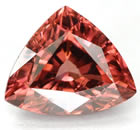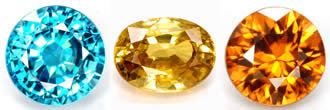Zircon and Zirconology - The Study of Zircon

Ancient Origins of Zircon
Most gemstones formed millions of years ago, but zircon stands out as truly exceptional. The oldest known zircon crystals, found in Western Australia, date back over 4.4 billion years. That makes zircon one of the very first minerals to appear on Earth.
Zircon as Earth's Archive
As our planet came together about 4.56 billion years ago, zircon was among the earliest crystals to form as molten granite cooled down. Though those ancient granitic rocks have eroded away over time, zircon hangs on as tiny, tough grains. It's like a time capsule preserving bits of Earth's earliest crust. Some zircon crystals even existed before the moon formed around 4 billion years ago - pretty mind-blowing when you think about it.

What is Zirconology?
Zircon has caught the attention of scientists to the point where it has its own dedicated field: zirconology. The structure of zircon can capture small amounts of uranium and thorium, which break down at predictable rates. This lets researchers date the crystals precisely with radiometric techniques. By analyzing oxygen isotopes in zircon, they've found evidence of water in Earth's crust more than 4 billion years ago. This has changed how we view the timeline for life's beginnings. If water showed up that early, life might have started sooner than we once believed - well before the first nucleated cells around 1.5 billion years ago. For further reading on zircon as a remarkable stone, explore our detailed zircon stone overview page.
Gemological Properties of Zircon
Beyond its role in geology, zircon interests gem experts too. It's an unusually dense mineral - about 50% denser than diamond. For instance, if a diamond weighs 1 carat, a zircon of similar dimensions might tip the scales at around 1.5 carats. Due to this density, zircon gems can seem smaller than their carat weight implies, so it's smart to measure carefully before buying. To dive deeper into the specifics of zircon as a gemstone, check out our comprehensive zircon gem information guide.

Optical Features and Cutting Challenges
Zircon displays strong birefringence, which means it has two refractive indices. Light entering a doubly refractive stone splits into two rays that take separate paths. This can make a zircon appear a bit fuzzy or show doubled facets when looked at through its table. That's why experienced cutters have to handle these effects thoughtfully.
Brilliance and Historical Uses
On top of its birefringence, zircon boasts a high refractive index (1.810–2.024), close to diamond's (2.417–2.419), and notable dispersion for outstanding sparkle. Before today's diamond imitations existed, white zircon served as a stand-in for diamonds. Just remember, zircon isn't the same as cubic zirconia, a synthetic option. Zircon is the oldest natural mineral we know on Earth - a real find for any gem enthusiast.

Frequently Asked Questions
How old are the oldest zircon crystals?
The oldest known zircon crystals, discovered in Western Australia, date back over 4.4 billion years.
What makes zircon useful for dating Earth's history?
Zircon traps uranium and thorium, which decay at known rates, allowing accurate radiometric dating. Oxygen isotope analysis also reveals early presence of water.
Why does zircon appear smaller than its carat weight?
Zircon is about 50% denser than diamond, so gems of similar size weigh more, making them seem smaller for their weight.
What is birefringence in zircon?
Birefringence means zircon has two refractive indices, causing light to split and sometimes creating a fuzzy look or doubled facets.
Is zircon the same as cubic zirconia?
No, zircon is a natural mineral, while cubic zirconia is a lab-created diamond simulant.

